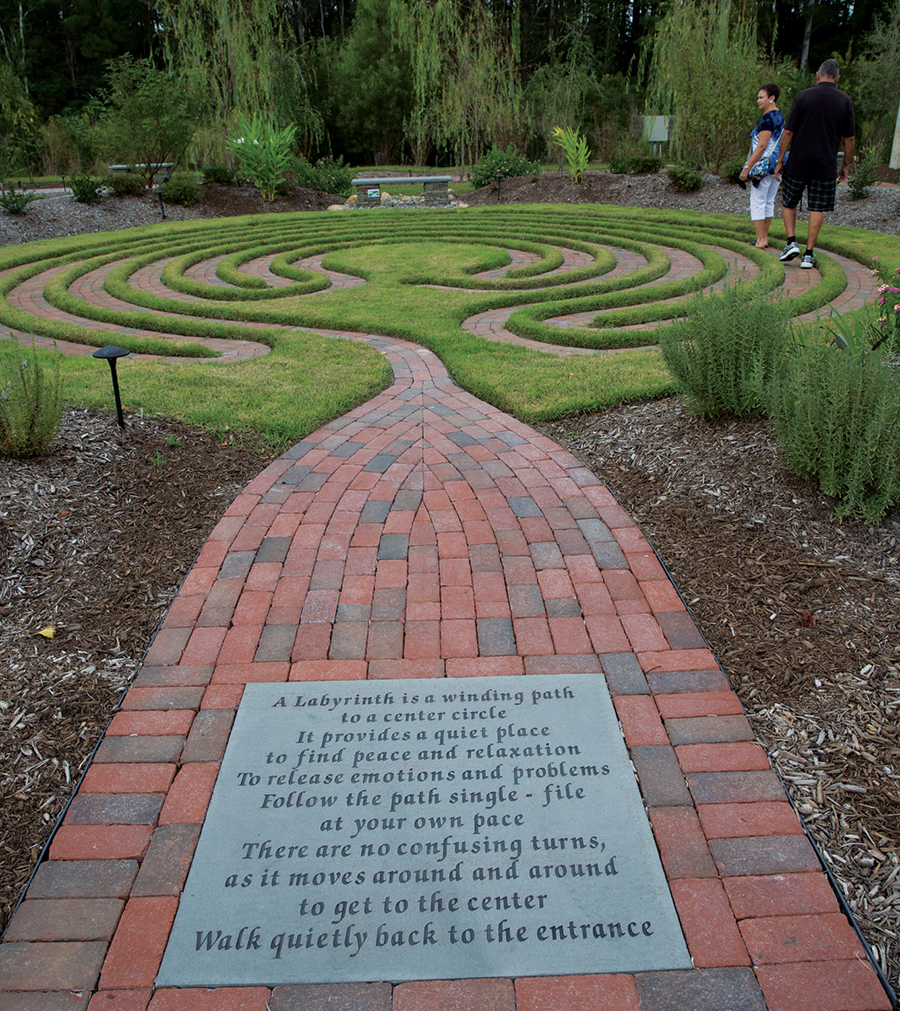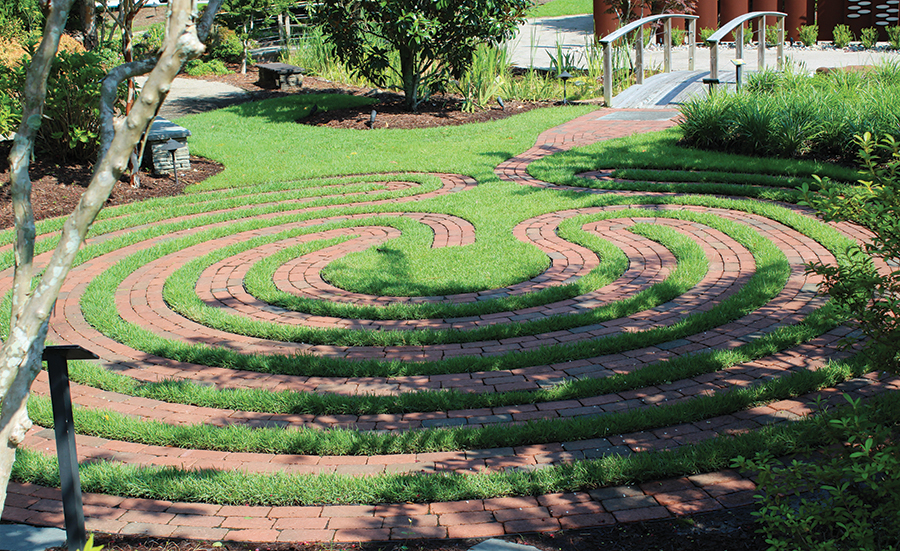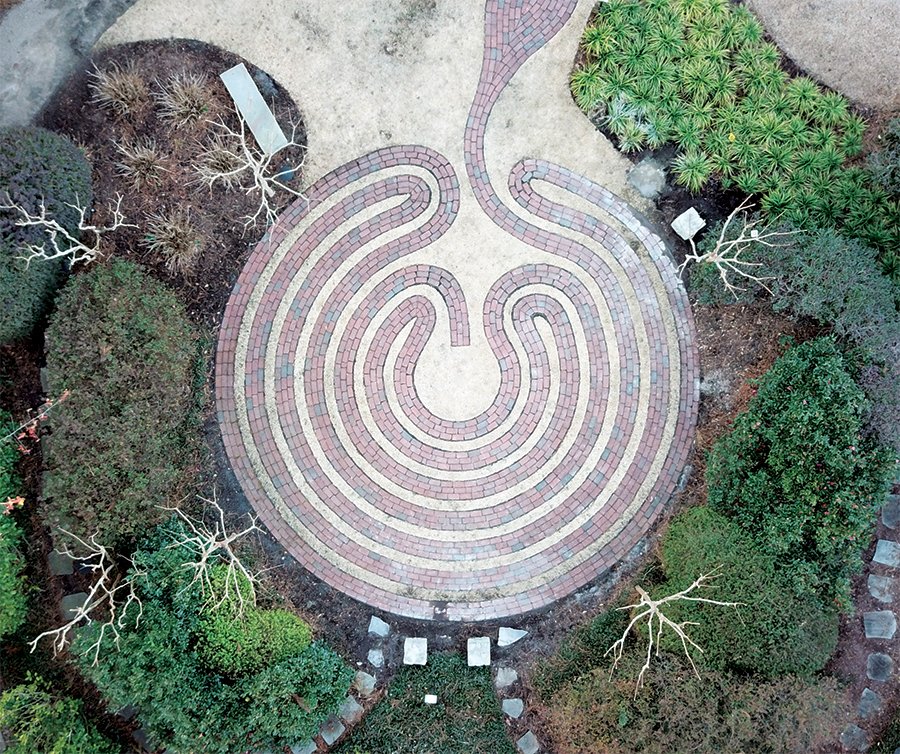From the profane to the sacred, labyrinths are an ancient tool for journeying within
By Barbara J. Sullivan
Imagine you live in Sweden by the Baltic Sea, and the time is somewhere in the 13th century. You and all your friends depend on the men bringing in a good day’s catch of cod and herring — but the problem is, you’re plagued by trolls. Trolls, small as they are, can cause a lot of heartache — especially to fishermen setting out to sea in rough waters. Why not confuse the little people and even temporarily imprison them until the boats return safely?
Easily done. Just create a boulder-lined walkway along the ground, leading the rambling imps along a spiraling path that turns back on itself over and over again until the little people, disoriented and confused, reach the center, where they’re kept out of harm’s way. This was the very popular design concept behind hundreds of stone formations along the coast of Sweden, which can still be seen today. The sea-going Swedes formed these labyrinths in the classic “unicursal” pattern, meaning that there was only one way in and only one way out, no dead ends or false turns.
Trolls or no trolls, the whole concept of creating winding, switchback labyrinths seems to have hit a sweet spot in the human imagination across the planet, going back in time as far as the very beginnings of human art and architecture.
If you count wall drawings, basket-weaving designs, pottery decoration, coins, clothing patterns and indoor flooring, you could say that labyrinths have been a worldwide craze for millennia: The symbol appears in Neolithic rock carvings in Europe; Native American petroglyphs in Arizona; art and architecture of ancient Greece and Rome; in pharaonic Egypt, in India, Sumatra, Java and China; and abundantly in most parts of Europe and the British Isles.
It seems that humans of every age and culture have had an affinity for labyrinths. On a warm spring night in England, sometime in the distant medieval past, the village green (conveniently carved up into a turf labyrinth) would be just the place for young men and women to dance their way in and out of a fertility ritual. Across the English Channel, the vast stone cathedral-floor labyrinths of Chartres, Amiens or Reims in France would have provided a much more sober and reverential pathway — the goals in this case being prayer and penance. The labyrinth, whatever its uses, seems to be deeply satisfying as a universal, human-devised pattern.

We tend to equate the labyrinth with its near-relative, the tricky and confounding maze. A maze is purposely designed to frustrate the visitor, in a playful manner, with its many branching paths and dead-end corridors. Whether it’s the English garden mazes of clipped yew or boxwood, or the currently popular corn mazes springing up all across the U.S., mazes are for entertainment, above all else. Labyrinths are different from mazes. They have a much more complex and, at times, deeply serious aspect. The center of the labyrinth may be the dwelling place of the trickster, the monster or the spirit of evil. Just as often, reaching the center of a labyrinth may signify an access to grace, enlightenment or contact with the sacred.
Very often, walking the labyrinth is symbolic of a journey in which something is given up once the visitor reaches the center and something new is attained upon exiting. It could be a meditative journey from the profane to the sacred, from death to rebirth, from trauma to healing. Labyrinths are purposely only wide enough for one person to walk along. Because of the twists and turns, footsteps have to be careful, slow and deliberate. This slow walking has been found to reduce respiratory rates, lower blood pressure and relieve stress. Apart from these physical benefits, labyrinths are now widely accepted as tools for coping with trauma and grief.
Lorraine Perry is a healing arts therapist, an avid gardener and a member of the congregation of the Church of the Servant in Wilmington, North Carolina. Back in 2003, those disparate elements coalesced in an unexpected way, and all of southeastern North Carolina has since become the beneficiary. On that day 17 years ago, Perry stepped out of her car at the Lower Cape Fear Hospice Care Center (LCFHCC), where she was scheduled to conduct horticulture therapy, and she saw a bright shaft of light radiating down through a stand of pine trees. An idea struck her — born of visits to English garden labyrinths and meditative walks along the floor labyrinth at her own church. This would be a perfect spot for a garden labyrinth for those hospice patients who were ambulatory, for caregivers, for staff and for other visitors.

With the blessing of the LCFHCC board and the generous contributions of money and labor from members of the Church of the Servant, her vision became a reality. A gravel and brick labyrinth, based on the classical unicursal design, was installed in the center of the pine grove. Years later, when the site was needed for a building addition, the original labyrinth was torn up. However, by that time, its value as a healing tool had become so abundantly clear that LCFHCC engaged a local landscaping company to design and install a beautiful new labyrinth as the centerpiece for its Heritage Garden. Since then, they have also installed a garden labyrinth at the Brunswick Hospice Care Center in Bolivia, North Carolina.
In the Wilmington hospice center garden, visitors are greeted by natural beauty all four seasons of the year — whether it’s the bright red and orange fall foliage of Japanese maples, the winter pinks of camellias, the pastels of spring azaleas and water irises, or the drifts of summer color from black-eyed Susans, Mexican petunias, canna lilies and roses. The garden is profuse with perennials, flowering shrubs and multi-textured evergreen foliage. Benches provide spots for rest and contemplation, and a stream ripples gently under a series of small bridges providing a soft background murmur.
In the secret garden gazebo behind the labyrinth, butterfly and chrysalis sculptures by local artist Dumay Gorham hang from above, suggesting the patterns of change and rebirth. Elsewhere in the garden, the large bronze sculpture, Safe Passage, by Karen Crouch, echoes Native American creation myths in which all of life grows out of the back a turtle. In this case the turtle’s shell hosts a branching tree with a large seed pod nestled in its branches, suggesting regeneration and the cycles of life.
The hospice garden labyrinth is made of brick and turf grass, is of classic unicursal design, and is just wide enough for one person to walk along. In Perry’s work at the care center she may provide help to a caregiver who’s going through the death of a loved one and is unsure of what awaits him or her at the end of that journey. She might say, “Let’s take a walk in the labyrinth, and the labyrinth might ground you emotionally so you can think more clearly about what lies ahead.”

DCIM100MEDIADJI_0445.JPG
She explains that she won’t be walking the labyrinth herself, but she will ask that the person wait for her when he or she reaches the center. Once they meet in the center she may say, “I’d like you to use this time to feel the grass beneath your feet and see if it provides a grounding that will then charge you with the ability to walk out of the labyrinth with some peace.” The walk in is for discovery, Perry explains. The walk out is for resolution. Over the many years that she has used the labyrinth in her healing arts work she has found it to be an invaluable tool.
Anyone can make a walking labyrinth. It can be as ephemeral as tracings on the sand at the beach, colorful flower petals arrayed on a patch of lawn, smooth stones arranged in a shallow stream. There are even labyrinths in the middle of the woods where the walking path coils back and forth among the trees. Garden labyrinths can be outlined in whatever catches the gardener’s fancy: zinnias or kale, native grasses or seashells.
In my own backyard, after having a professional stonemason lay out the path, I planted dwarf Mondo grass, dwarf narcissus and poppies in the furrows in between. And yes, I can attest that walking the labyrinth does slow down your breathing and reduce stress. It is a great place for meditation and relaxation.
Most importantly, however, I am finally rid of those pesky garden trolls.
Barbara Sullivan is a regular Salt contributor and the author of Garden Perennials for the Coastal South.

